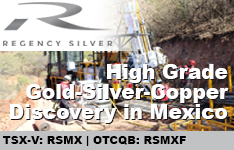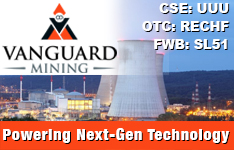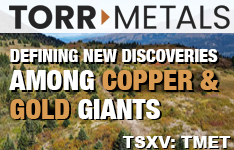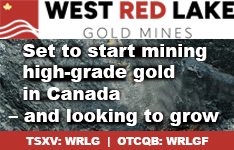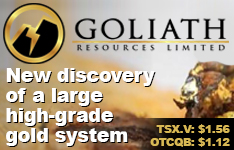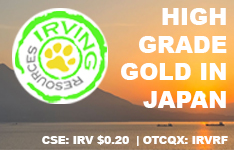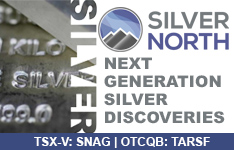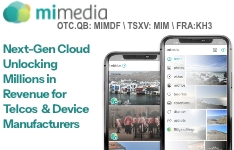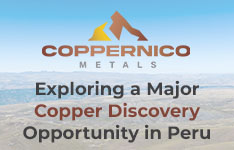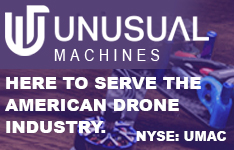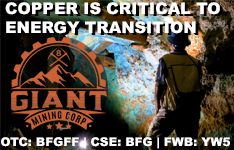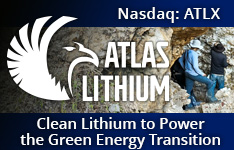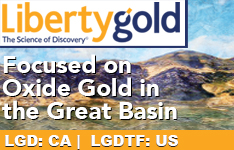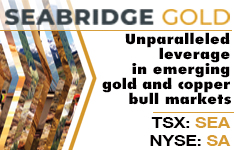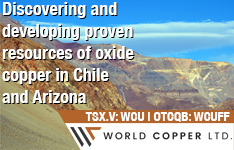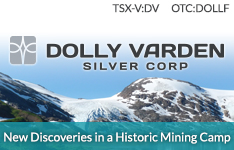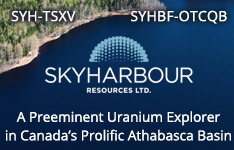Stifel increased its copper and uranium price forecasts based on market vulnerability to supply shocks, Managing Director Ralph Profiti wrote in a Q3/25 Industrial Metals Results Preview dated October 21.
Here's a look at Stifel's new and previous price estimates for both metals:
| METAL | PERIOD | NEW ESTIMATE | OLD ESTIMATE | % CHANGE |
| Copper | 2025 | US$4.45/lb | US$4.34/lb | +2 |
| Copper | 2026 | US$4.85/lb | US$4.40/lb | +10 |
| Copper | 2027-2028 | US$5.00/lb | US$4.25/lb | +18 |
| Copper | Long term | US$4.50/lb | US$4.25/lb | +6 |
| Uranium | Long term | US$120/lb | US$105/lb | +14 |
Effects of Supply Disruptions
Recent copper supply disruptions at various mines, including Grasberg Block Cave (GBC), Kamoa-Kakula, Quebrada Blanca and Constancia) will account for 1,100,000 fewer tons of the red metal on the market over the next three years (through 2027), Stifel estimated. This bears out Stifel's long-held believe that the market is vulnerable to unanticipated supply shocks. The timing of the shocks exacerbates the supply problem; they came after a decade of underinvestment in new mines, prices remaining below incentive levels and relatively low inventories.
Stifel's long-term copper price forecast of US$4.50/lb is conservative against the current spot price of US$4.97/lb, Profiti wrote. It is consistent, though, with pricing assumptions to be used for long-term capital allocation decisions by copper producers and Stifel's long-term incentive price estimate of US$5.04/lb.
Consensus long-term copper prices are low, noted Profiti, when one takes into account the structurally higher all-in costs of building new capacity, higher operating costs, risk of construction delays, higher royalties and taxation, and increased permitting and social license risks at emerging supply centers. All of these factors support Stifel's view that long-term copper prices above spot prices are justified.
Stifel's preferred industrial metals picks are Cameco Corp. (CCO:TSX; CCJ:NYSE), Capstone Copper Mining Corp. (CS:TSX), Foran Mining Corp. (FOM:TSX.V), HudBay Minerals Inc. (HBM:TSX; HBM:NYSE), IsoEnergy Ltd. (ISO:TSX), Lundin Mining Corp. (LUN:TSX; LUNMF:OTCMKTS), Taseko Mines Ltd. (TKO:TSX; TGB:NYSE.MKT) and Western Copper and Gold Corp. (WRN:TSX; WRN:NYSE.MKT).
Uranium Supply Constrained
As for uranium, Stifel predicts market deficits through 2029, Profiti wrote. Drivers are moderate growth of mine production and execution risk linked to several key projects.
Stifel's Top Pick in uranium is NexGen Energy Ltd. (NXE:TSX; NXE:NYSE.MKT).
"Once fully permitted, we believe Rook 1 will hold strategic significance as a construction-ready, high-margin, long-life, technically derisked asset in a premier mining jurisdiction that should attract mergers and acquisitions interest from competing uranium producers as well as nuclear value chain participants that should command a premium valuation," Profiti wrote.
| Want to be the first to know about interesting Copper and Uranium investment ideas? Sign up to receive the FREE Streetwise Reports' newsletter. | Subscribe |
Important Disclosures:
- Doresa Banning wrote this article for Streetwise Reports LLC and provides services to Streetwise Reports as an independent contractor.
- This article does not constitute investment advice and is not a solicitation for any investment. Streetwise Reports does not render general or specific investment advice and the information on Streetwise Reports should not be considered a recommendation to buy or sell any security. Each reader is encouraged to consult with his or her personal financial adviser and perform their own comprehensive investment research. By opening this page, each reader accepts and agrees to Streetwise Reports' terms of use and full legal disclaimer. Streetwise Reports does not endorse or recommend the business, products, services or securities of any company.
For additional disclosures, please click here.
Disclosures for Stifel, October 21, 2025
Investment Thesis Arizona Metals Corp. (AMC CN) High-grade historical resource a head start for exploration at Kay. Kay hosts a historical non-NI 43-101 compliant high-grade (approximately 6% CuEq) resource of 5.8MMt by Exxon from 1982. Proven district. There are 60 past-producing VMS mines within 150km of Kay. Freeport and Grupo Mexico have significant vertical infrastructure close by. Tier 1 jurisdiction. Kay is on private or BLM land, with no royalties. The property is also not close to the National Forests. Arizona produces the majority of the U.S.’s copper. Property-wide exploration at Kay leaves the door open for a ‘beachhead’ development strategy. Two high-priority targets exist to the west of Kay, with strongly similar surficial geochemical and geophysical signatures to Kay. AMC is in the process of proving up its “accordion folding thesis” that intimates that mineralization at Kay is repeated at these two targets. Arizona Sonoran Copper Company Inc. (ASCU CN) Arizona Sonoran's Cactus Project is a low-risk, conventional open-pit mining project with a straightforward development path that can translate into quick time to market. Located on a brownfield site with access to requisite infrastructure, Cactus requires only state permits, avoiding the lengthier federal process. A JV agreement for Cactus signed with Rio Tinto lends industry confidence and financial muscle to the project, while Rio's Nuton technology could provide material upside beyond our base case by unlocking the potential of the primary sulphide resource. Strategic tension for Cactus should remain strong given project scale and possible synergistic integration with the neighbouring Santa Cruz copper project. ATEX Resources Inc. (ATX CN) Big getting bigger and better. Giant PCDs occur in geologic Belts down the spine of the Andes at structural intersections. Valeriano’s 1-2 punch of favourable structure and duration of mineralization intimate potential for both a sizable porphyry system and high grade starter breccia system, which drive asset critical mass as well as competitive tension. Right time to own. Efficiently adding metal via discovery is paramount to value creation. ATEX’s discovery rate is 3.5x that of other porphyry explorcos, providing investors with torque to an efficient drill bit. District consolidation potential. Copper deposits are increasingly becoming lower grade and deeper, driving consolidation to diversify risk, with ABX/ANTO’s El Encierro JV outlining +$100MM in exploration spend next door. Cameco Corp. (CCO CN) We believe Cameco is well-positioned for improved financial performance driven by our forecasts of rising uranium prices, exposure to market-related contract terms and the benefits of growth opportunities amid vertical integration in the Uranium and Fuel Services businesses through its 49% stake in the Westinghouse Electric Co. (WEC - private) – which we view as the most undervalued part of the business. Increased interest from traditional resource investors, energy investors, clean energy investors, infrastructure investors and generalists reinforces our view of peak-uranium valuation. Capstone Copper (CS CN) Capstone is a mid-tier base metals producer offering investors one of the highest exposures to copper within our peer group of our diversified miners. Capstone's path from 185Kt to 260Kt of annualized copper production will be driven by full MVDP ramp-up and MV-Optimized and incremental growth to 400+Kt driven by Santo Domingo startup (2029) and other low-risk/capital-efficient expansions at Mantos Blancos (Phase II) and Mantoverde (MV-SD Cobalt and MV-Phase II). Near-term run-rate annualized copper production growth to 260Kt would rank Capstone around #20 globally, which in our view, is ideally positioned for “mid-tier appeal” and a lack of complexity given 70% of NAV resides in Chile, marks Capstone as one of our top copper M&A target picks. Ero Copper (ERO CN) Ero Copper offers investors exposure to a high-margin, growth-oriented copper-gold producer with a strategic focus on Brazil and mid-tier target M&A appeal, while we anticipate a slower production ramp-up in H2/25 and 2026. Ero is positioned to deliver meaningful production growth through stabilized Caraíba operations post its mill expansion completed in Dec-2023 as well as Tucumã ramp-up which achieved commercial production on July 3, 2025. We expect Ero to prioritize stronger cash flow generation towards balance sheet deleveraging and transformational drilling at Furnas in partnership with Vale Base Metals (VBM) where 40,000m of drilling planned for 2025 will support a Phase 1 Scoping Study (PEA) in H1/26 and Phase 2 Pre-feasibility Study with ongoing exploration and technical studies aiming to define a new long-life, high-grade underground mine. We anticipate a slower production ramp-up in H2/25 and 2026, while we believe Ero is still well positioned to achieve higher copper production 2026 and 2027 with annual copper production growth of 85–95Kt (vs. 40.6Kt in 2024), which underpins our view of Ero as a consolidation play in the mid-tier copper sector. Freeport-McMoRan Inc. (FCX) We believe Freeport is one of the best-positioned miners globally for copper and gold exposure with large-scale production of copper, gold and molybdenum, a highly qualified and experienced team with a proven track record of operational execution, disciplined capital allocation and outsized shareholder returns. Freeport boasts an attractive portfolio of organic growth opportunities anchored with a strong balance sheet including its proprietary leaching technology that unlocks significant value from existing stockpiles at a very low capital intensity, which we value at $6+/share, including Q1/25 extraction of 40Mln lbs of copper from leaching initiatives that has demonstrated early success with technological viability that leverages data analytics and optimized processes (leach kinetics and proprietary reagents) to target low-grade ores, potentially 38Bln lbs in copper stockpiles, into profitable output. Freeport’s target run-rate of 300Mln lbs/year by YE25 and 300-400Mln lbs/year in 2026, and 800Mln lbs/year by 2030 at an estimated cash cost of $1.50-2.00/lb is equivalent to a Tier One copper asset. Firefly Metals Ltd. (FFM CN) We see a dual-track of value creation potential for Firefly based on a) De-risking their flagship Green Bay Project in Newfoundland's Baie Verte peninsula, which enjoys a significant head-start thanks to established infrastructure centred around the past-producing Ming Mine and b) continued exploration at Ming and across a 326 sq km regional land package that contains several historical mines. First Quantum Minerals (FM CN) We believe our copper price forecasts drive an opportunistic relative risk:reward ratio of how Cobre Panama is priced into the shares, which we view as undervalues considering restart potential. FM continues to target resolution by YE25 and maintains a public outreach program to ensure transparency and stakeholder engagement. First Quantum has a strong track record and technical expertise with large copper porphyry deposits affords significant opportunities to achieve value accretion in the long-term through risk reduction efforts such as advancing permitting, potential for streaming agreements, progressing to feasibility study status, and execution to better define scope and scale. Foran Mining Corporation (FOM CN) World-class VMS belt keeps on giving. The Flin Flon Greenstone Belt is one of the most well-endowed VMS belts in Canada, having produced over 320MMt of Cu-Zn (±Au, Ag, Pb) ore from over 29 deposits. FOM controls the western front and has already proved up the third-largest resource in the belt at ~45MMt. First-mover geology without first-mover costs. FOM has the competitive advantage of controlling the under-exploited western front of the Flin Flon Greenstone Belt, with a large amount of sunk capital in the form of infrastructure already paid for by HudBay. Not all tonnes produced & financed equally – green copper. Foran is planning to rewrite the book on value creation in the mining industry by becoming the world’s first carbon-neutral mine on day one. This is good for the environment, and good for shareholders, as it helps to drive down the cost of capital. Long list of backers keeps growing. We believe Foran's management is aligned with shareholders. Management, Pierre Lassonde and Fairfax own greater than 40% of the company. The strong institutional ownership and interest are only growing, in our view. HudBay Minerals (HBM CN) HudBay is a growth-oriented mid-tier base metals producer high leverage to copper and one of the most undervalued names in our peer group of diversified miners, with significant leverage to gold and zinc. We forecast stronger FCF in 2026 driven by strong Manitoba performance, operational sustainability at Copper Mountain and higher production potential at Constancia, positions the balance sheet favourably ahead of a construction decision at Copper World in Q1/26. The Peru Government’s approved regulatory change to allow mining companies to increase mill throughput by up to 10% above permitted levels allows Constancia to potentially increase production by 2026 and is not currently in our estimates. IsoEnergy Ltd. (ISO CN) IsoEnergy's asset base offers investors a rare blend of near-term U.S. production and high-grade Canadian exploration upside. In the U.S., the fully permitted Tony M. Mine postions the company to capitalize on increasing energy security and on-shoring policy momentum. With low capex and near-term production potential we view Tony M as a uniquely attractive - and underappreciated for its reduced permitting and execution risk in a structurally under-supplied domestic U.S. uranium market. In Canada, IsoEnergy's flagship Hurricane deposit ranks amoung the highest-grade undeveloped uranium assets globally. Strategically located in the Athabasca basin, Hurricane sits adjacent to heavyweight neighbours, and with growing relevance in the next wave of Athabasca uranium development, we see opportunity for a re-rate driven by regional consolidation pressure. IsoEnergy's disciplined yet aggressive approach to exploration adds further upside opportunity, positioning the company well to unlock blue-sky value creation through the drill bit. Ivanhoe Mines Ltd. (IVN CN) We believe Ivanhoe’s cash flow transition from more capex-intensive build-out and expansion to significant production growth with high-margin value capture has been deferred due to the temporary suspension at Kakula underground. Long-term objectives and deliverables are still preserved and represent a compelling risk-reward trade-off on medium-term value, and we still consider Kamoa-Kakula as having multi-stage expansion and optimization potential. Ivanhoe’s asset base is distinguished by its high-grade, long-life deposits and substantial infrastructure already in place. Platreef is an ultra-scale, high-margin polymetallic orebody standing out with a combination of grade, thickness, geometry, scale and potential for significant byproduct credits as Phase 1 begins commissioning in Q4/25 and Kipushi that reintroduces a highest-grade zinc supply. Together with an underappreciated brownfield and greenfield exploration portfolio (Western Forelands), Ivanhoe’s assets offer a visible multi-year growth pipeline with scale. National Atomic Company Kazatomprom JSC (KAP LI) We believe KAP will maintain its global market leadership in uranium production and grow its contracted volumes under long-term relationships with utilities. Despite consensus estimates and market valuations continuing to absorb the impacts of sulphuric acid availability on supply chains and production capability rates, construction delay challenges on wellfield development, the potential impacts to 2025 production guidance due to the temporary production suspension at JV Inkai and the impact of the newly introduced Mineral Extraction Tax (MET), we believe the shares offer a compelling risk:reward trade-off in the context of relative valuation vs the historical range, supportive trends in our uranium spot and term price forecasts and the potential for outsized dividends in 2025 and 2026. Lundin Mining (LUN CN) Lundin Mining is a diversified base metal growth story increasingly anchored in the Andean region of South America following the sale of its European assets. Lundin's two operating Chilean copper mines (Candelaria & Caserones) account for 70% of our estimated net asset value, with Josemaria/ Vicuña District accounting for 20%. We believe Lundin 's joint offer to acquire Filo Mining and form a 50/50 JV to progress the Filo del Sol and Josemaria projects illustrates our view of high-quality, large-scale, undeveloped copper projects that are not already owned by majors holds strategic importance in the next copper cycle. The transaction and JV follows compelling strategic rationale that facilitates development optionality of the Vicuña District and the proximity of the Filo del Sol and Josemaria projects allows for the potential of shared infrastructure (primarily port and desalination capacity) with greater economies of scale and increased optionality for staged expansions, as well as the incorporation of exploration potential. We see a path towards accelerated development that leverages the advanced stage of engineering and permitting at Josemaria that progress a combined Filo del Sol and Josemaria on a phased development timeline. NexGen Energy Ltd. (NXE CN) Steady run-rate production at the Rook 1 project on a stand-alone basis is expected to rival Cameco’s entire Canadian production profile on an attributable basis, marking the project as one of the most important supply catalysts and strategic source of uncommitted production in the 2030-2036 period that is expected to be sought by U.S. utilities as future U.S. domestic uranium production cannot meet requirements and where reliable, scalable sources of new supply are expected to remain very scarce. We further believe Rook 1 holds strategic significance as a constructionready (once fully permitted), high-margin, long-life, technically de-risked asset in a premier mining jurisdiction that should attract M&A interest from competing uranium producers as well as nuclear value chain participants and should command a premium valuation. Teck Resources (TECK/B CN) We believe a long-term focus is necessary in positioning Teck shares as it navigates short-term copper growth projects at San Nicolas and Zafranal and longer-dated copper growth optionality at NewRange, Galore Creek, NuevaUnión, Schaft Creek, that in our view, will be more challenged to execute positive risk-adjusted IRRs and reinforces the relative merits of our “buy vs. build” thesis in the copper sector. We believe strongly that Teck's Capital Allocation Framework strikes the proper balance between debt reduction, retaining significant cash for copper growth, ensuring maintenance of a strong balance sheet, and providing cash returns to shareholders while reinforcing mgmt.’s core competencies and should be the focus for long-term oriented investors. We see Teck as a viable consolidator in the copper sector based on its strong balance sheet and above-peer range market multiples. Taseko Mines (TKO CN) Proven operational viability, world-class jurisdictions, readily available funds to start construction and a strong copper market backdrop ideally position Taseko to propel its growth trajectory by moving Florence into production. With permits and funding secured, we see 2025 production start-up as achievable, ultimately resulting in Taseko's consolidated copper production increasing to nearly 200 Mlb by 2027. Uranium Energy Corp. (UEC) Uranium Energy Corp. (UEC) is rapidly growing its production caliber in the United States, offering near-term production growth from the development of several US in-situ assets while providing exploration upside opportunities from its assets in the world-renowned Athabasca Basin. Management has a track record of execution and through a series of opportunistic M&A transactions has increased scale and near-term production optionality over the past five years, supporting the asset portfolio with accretive transactions, which supports our belief that UEC will be able to deliver the next phase of growth, as the company transitions to junior producer status. With a business model focused on maintaining 100% unhedged exposure to uranium prices, UEC has peer-leading trading liquidity and a significant US investor following. Western Copper & Gold Corp. (WRN CN) Casino is a key development asset in an emerging mining district and a strategic pillar to Canada’s nation-building framework. The Casino Project, located in the Whitehorse Mining District in west-central Yukon (Canada), hosts one of the world’s largest undeveloped copper-gold deposits. We believe Casino’s development optionality as a large-scale, open-pit copper porphyry in a Tier One jurisdiction, with a low-strip ratio and low cash costs owing to significant gold credits, ideally positions WRN for a continued re-rating against a backdrop of project de-risking catalysts (permitting, power and partnerships) and our forecasted increasing copper market deficits beginning in 2028 and our estimated startup in 2032. Large-scale, high-quality, undeveloped copper-gold projects in favourable jurisdictions should command strategic importance and premium valuations in the next copper cycle due to their scarcity, size and suitability for conventional mining. Casino is well-positioned as an M&A target, offering exposure to a high-grade porphyry with district-scale potential and improving infrastructure access expected to enhance project economics. Target Price Methodology/Risks Arizona Metals Corp. (AMC CN) Via a 0.80x NAV multiple used to reflect the resource definition stage of the project, our target price is C$2.50/sh. Market risk/gold price – Profitability and cash flow will be directly impacted by changes in gold prices. A material decline in gold/metal prices would adversely affect profitability, cash flow and may also render certain projects uneconomical. Price and cost instability – In addition to gold/metal prices, foreign currency rates and the costs of various input materials associated with mining can fluctuate substantially, resulting in a negative impact on the company’s profitability. Technical risk and economic viability – Mining operations/projects can be exposed to various operational risks that could impact cash flow and a company’s ability to secure future liquidity. Geopolitical risk – Mining operations/projects in higher geopolitical risk countries can be exposed to changes in government policies, such as permitting policies, licenses and tax laws, which can negatively impact the mining companies. Exploration – Exploration success cannot guarantee an increase in a mine’s/project’s resource base or conversion to mineral reserves. Arizona Sonoran Copper Company Inc. (ASCU CN) We calculate our NAV using a discount rate of 10% on the Cactus Project, then apply a 0.80x multiple to arrive at a TP of C$4.00/share. Risks: Commodity Price Risk: Any material decline in metal commodity prices from our estimates would negatively impact the profitability of projects and may also render them uneconomical. Operating Risk: There are several risks to which an operating company is exposed, including, but not limited to, cost escalations, equipment downtimes, labour unavailability and adverse climate, each of which could potentially render the operations unprofitable leading to NAV depletion.
Exploration/Resource Risk: Any issues with resource delineation or definition could adversely affect the profitability of the projects. Financing Risk: The execution of projects will be dependent on the company’s ability to fully fund the projects and advance them to a positive final investment decision. Execution Risk: There is the possibility that projects will not be able to advance into the mine phase. Construction Risk: A project during construction is subject to some engineering risks that might create unforeseen cost and schedule overruns, thus impacting economics. Company-Specific Risks: Several assumptions in our valuation are made, including estimates on mine life, throughput, metal recoveries, and unit costs. Such assumptions are subject to change as more project-specific information is available, which could adversely affect valuations. Jurisdictional Risk: Every asset is subject to varying types of risks depending on location. Such risks include government policies, taxation, import/export regulation, title rights, environmental regulations, complex permitting procedures and social challenges. ATEX Resources Inc. (ATX CN) We calculate our NAV using a discount rate of 10% on our HGBRX mine, and a $0.04/lb CuEq in situ multiple on the 2025 MRE porphyry resource, then apply a 0.65x multiple to arrive at a target price of C$4.50/share. Commodity Price Risk: any material decline in metal commodity prices from our estimates would negatively impact the profitability of projects and may also render them uneconomical. Operating Risk: there are a number of risks to which an operating company is exposed, including but not limited to, cost escalations, equipment downtimes, labour unavailability and adverse climate, each of which have the potential to render the operations unprofitable leading to NAV depletion. Exploration/Resource Risk: any issues with resource delineation or definition could adversely affect the profitability of the projects. Financing Risk: the execution of projects will be dependent on the company’s ability to fully fund the projects and advance them to a positive final investment decision. Execution Risk: there is the possibility that projects will not be able to advance into the mine phase. Construction Risks: a project during construction is subject to a number of engineering risks that might create unforeseen cost and schedule overruns, thus impacting economics. Company Specific Risk: several assumptions in our valuation are made, including estimates on mine life, throughput, metal recoveries and unit costs. Such assumptions are subject to change as more project specific information is available, which could adversely affect valuations. Jurisdictional Risk: every asset is subject to varying types of risks depending on its location. Such risks include government policies, taxation, import/export regulation, title rights, environmental regulations, complex permitting procedures and social challenges. Cameco Corp. (CCO CN) Our TP of C$150 is based on a sum-of-the parts value including 1.75x P/NPV on the Uranium Business reflecting historical peak P/NAV multiple during uranium “bull markets” of 1.6-1.8x and 20x FY30 EV/EBITDA on the WEC business. Market risk/metal prices: profitability will be directly impacted by changes in uranium prices. A material decline in uranium prices would adversely affect profitability and cash flow and may also render certain projects uneconomical. Counterparty risk, technical risk, and economic viability: mining projects can be exposed to various operational risks and external factors outside a company’s control that may alter the viability of a project's timelines and costs. These risks may also render certain projects uneconomical. Geopolitical risk: mining projects in higher geopolitical risk countries can be exposed to changes in government policies such as permitting policies, licenses and tax laws, which can negatively impact mining companies. Development risk: positive feasibility studies cannot guarantee successful development of a project. Development projects can be exposed to various risks that may significantly increase the cost of projects. Additionally, development project timelines can be subject to delays related to equipment, staffing, dewatering and other various items that may significantly alter a project's schedule and timeline to completion. Exploration: Exploration success cannot guarantee an increase in a mine or project's resource base, or conversion to mineral reserves. Capstone Copper (CS CN) Our target price of C$17.00 is derived using a blended multiple of 1.1x P/NAV at 8% discount rate and 6x FY27E EV/EBITDA. Commodity Price Risk: Any material decline in metal commodity prices from our estimates would negatively impact the profitability of projects and may also render them uneconomical. Operating Risk: There are several risks to which an operating company is exposed, including, but not limited to, cost escalations, equipment downtimes, labour unavailability and adverse climate, each of which could potentially render the operations unprofitable leading to NAV depletion. Exploration/Resource Risk: Any issues with resource delineation or definition could adversely affect the profitability of the projects. Financing Risk: The execution of projects will be dependent on the company’s ability to fully fund the projects and advance them to a positive final investment decision. Execution Risk: There is the possibility that projects will not be able to advance into the mine phase. Construction Risks: A project during construction is subject to some engineering risks that might create unforeseen cost and schedule overruns, thus impacting economics. Company-Specific Risk: Several assumptions in our valuation are made, including estimates on mine life, throughput, metal recoveries, and unit costs. Such assumptions are subject to change as more project-specific information is available, which could adversely affect valuations.
Jurisdictional Risk: Every asset is subject to varying types of risks depending on location. Such risks include government policies, taxation, import/ export regulation, title rights, environmental regulations, complex permitting procedures and social challenges. Ero Copper (ERO CN) Our TP of C$37.00 is based on a blended weighting of 1.0x on P/NAV and 5.0x our FY26/27E EV/EBITDA estimates based on a premium to 3Yr trailing average multiples due to stronger execution and improved balance sheet. Market risk/commodity price: profitability may be directly impacted by the changes in commodity prices in the product mix. Cost instability: fluctuations in foreign currency exchange rates and the costs of various input materials and consumables associated with mining activities can significantly impact the company’s profitability. Operating Risk: an operating company is exposed to multiple risks including, but not limited to, cost escalations, equipment downtime, labour shortages and adverse weather conditions, each of which could potentially render operations unprofitable and lead to a depletion of net asset value (NAV). Execution/ Construction Risk: for developers, project execution is not guaranteed, and some projects may not advance to the mining phase. Exploration/Resource Risk: exploration success does not guarantee an increase in a mines or projects’ resource base, nor its conversion to mineral reserves. Financing Risk: the execution of projects in the exploration or construction stage will depend on the company’s liquidity to fund the development and advance them toward a positive final investment decision. Geopolitical / jurisdictional risk: mining operations/projects in higher geopolitical risk countries can be exposed to uncertainties related to government policies including but not limited to permitting, licensing, taxation, import/export regulations, title rights, environmental laws and social challenges. Freeport-McMoRan Inc. (FCX) Our TP of US$52.00 is based on a blended weighting of 1.0x P/NAV and 6.0x our FY27/28E EV/EBITDA estimates based on 3Yr trailing average multiples. Market risk/commodity price: profitability may be directly impacted by the changes in commodity prices in the product mix. Cost instability: fluctuations in foreign currency exchange rates and the costs of various input materials and consumables associated with mining activities can significantly impact the company’s profitability. Operating Risk: an operating company is exposed to multiple risks including, but not limited to, cost escalations, equipment downtimes, labour shortages and adverse weather conditions, each of which could potentially render operations unprofitable and lead to a depletion of net asset value (NAV). Execution/ Construction Risk: for developers, project execution is not guaranteed and some projects may not advance to the mining phase. Exploration/Resource Risk: exploration success does not guarantee an increase in a mines or projects’ resource base, nor its conversion to mineral reserves. Financing Risk: the execution of projects in the exploration or construction stage will depend on the company’s liquidity to fund the development and advance them toward a positive final investment decision. Geopolitical / jurisdictional risk: mining operations/projects in higher geopolitical risk countries can be exposed to uncertainties related to government policies including but not limited to permitting, licensing, taxation, import/export regulations, title rights, environmental laws and social challenges. Firefly Metals Ltd. (FFM CN) We calculate our NAV using a discount rate of 8% on the Green Bay, a $50/oz in-situ value for Pickle Crow, then apply a 0.85x multiple to arrive at a TP of C$2.00/share. Commodity Price Risk: any material decline in metal commodity prices from our estimates would negatively impact the profitability of projects and may also render them uneconomical. Operating Risk: there are a number of risks to which an operating company is exposed, including but not limited to, cost escalations, equipment downtimes, labour unavailability and adverse climate, each of which have the potential to render the operations unprofitable leading to NAV depletion. Exploration/Resource Risk: any issues with resource delineation or definition could adversely affect the profitability of the projects. Financing Risk: the execution of projects will be dependent on the company’s ability to fully fund the projects and advance them to a positive final investment decision. Execution Risk: there is the possibility that projects will not be able to advance into the mine phase. Construction Risks: a project during construction is subject to a number of engineering risks that might create unforeseen cost and schedule overruns, thus impacting economics. Company Specific Risk: several assumptions in our valuation are made, including estimates on mine life, throughput, metal recoveries and unit costs. Such assumptions are subject to change as more project specific information is available, which could adversely affect valuations. Jurisdictional Risk: every asset is subject to varying types of risks depending on its location. Such risks include government policies, taxation, import/export regulation, title rights, environmental regulations, complex permitting procedures and social challenges. First Quantum Minerals (FM CN) Our target price of C$38.00 is derived using a 1.0x P/NAV and 5.5x our FY28/29/30E EV/EBITDA estimates based on 3Yr trailing average multiples.
Commodity Price Risk: Any material decline in metal commodity prices from our estimates would negatively impact the profitability of projects and may also render them uneconomical. Operating Risk: There are a number of risks to which an operating company is exposed, including, but not limited to, cost escalations, equipment downtimes, labour unavailability and adverse climate, each of which has the potential to render the operations unprofitable leading to NAV depletion. Exploration/Resource Risk: Any issues with resource delineation or definition could adversely affect the profitability of the projects. Financing Risk: The execution of projects will be dependent on the company’s ability to fully fund the projects and advance them to a positive final investment decision. Execution Risk: There is the possibility that projects will be unable to advance into the mine phase. Construction Risks: A project during construction is subject to a number of engineering risks that might create unforeseen costs and schedule overruns, impacting economics. Company-Specific Risk: Assumptions include estimates on mine life, throughput, metal recoveries and unit costs. Assumptions are subject to change as more project-specific information is available, potentially affecting valuations. Jurisdictional Risk: Every asset is subject to varying types of risks depending on its location. Risks include government policies, taxation, import/ export regulation, title rights, environmental regulations, complex permitting procedures and social challenges. Foran Mining Corporation (FOM CN) We use an 8% discount on our DCF valuation to reflect the pre-development stage of the project. We use a 0.95x multiple to reflect the lack of jurisdictional risk, competitive land package and lack of high-grade, quality base metal projects in Canada. Via a 0.95x NAV multiple, and long-term USD:CAD FX of 0.71, our target price is C$5.50/sh. Risks Market risk/gold price – Profitability and cash flow will be directly impacted by changes in gold prices. A material decline in gold/metal prices would adversely affect profitability, cash flow and may also render certain projects uneconomical. Price and cost instability – In addition to gold/metal prices, foreign currency rates and the costs of various input materials associated with mining can fluctuate substantially, resulting in a negative impact on the company’s profitability. Technical risk and economic viability – Mining operations/projects can be exposed to various operational risks that could impact cash flow and a company’s ability to secure future liquidity. Geopolitical risk – Mining operations/projects in higher geopolitical risk countries can be exposed to changes in government policies, such as permitting policies, licenses and tax laws, which can negatively impact the mining companies. Exploration – Exploration success cannot guarantee an increase in a mine’s/project’s resource base or conversion to mineral reserves. HudBay Minerals (HBM CN) Our target price of C$28.00 is derived using a blended multiple of 1.1x P/NAV at 8% discount rate(9% for Copper World project) and 6x FY27/28E EV/EBITDA. Commodity Price Risk: Any material decline in metal commodity prices from our estimates would negatively impact the profitability of projects and may also render them uneconomical. Operating Risk: There are a number of risks to which an operating company is exposed, including, but not limited to, cost escalations, equipment downtimes, labour unavailability and adverse climate, each of which has the potential to render the operations unprofitable leading to NAV depletion. Exploration/Resource Risk: Any issues with resource delineation or definition could adversely affect the profitability of the projects. Financing Risk: The execution of projects will be dependent on the company’s ability to fully fund the projects and advance them to a positive final investment decision. Execution Risk: There is the possibility that projects will not be able to advance into the mine phase. Construction Risks: A project during construction is subject to a number of engineering risks that might create unforeseen costs and schedule overruns, thus impacting economics. Company Specific Risk: Assumptions include estimates on mine life, throughput, metal recoveries, and unit costs. Such assumptions are subject to change as more project-specific information is available, which could adversely affect valuations. Jurisdictional Risk: Every asset is subject to varying types of risks depending on its location. Such risks include government policies, taxation, import/export regulation, title rights, environmental regulations, complex permitting procedures and social challenges. IsoEnergy Ltd. (ISO CN) Our target price of C$25.00 is derived using a multiple of 0.9x P/NAV to our NAVPS at 8% discount rate (10% for Larocque East project), reflecting historical peak P/NAV multiple during uranium “bull markets”. Key Risks: Market risk/metal prices: profitability will be directly impacted by changes in uranium prices. A material decline in uranium prices would adversely affect profitability and cash flow and may also render certain projects uneconomical. Counterparty risk, technical risk and economic viability: mining projects can be exposed to various operational risks and external factors outside of a company’s control that may alter the viability of a project’s timelines and costs. These risks can/may also render certain projects uneconomical.
Geopolitical risk: mining projects in higher geopolitical risk countries can be exposed to changes in government policies such as permitting policies, licenses and tax laws, which can negatively impact the mining companies. Development risk: technical studies cannot guarantee successful development of a project. Development projects can be exposed to various risks that may significantly increase the cost of a project. Additionally, development project timelines can be subject to delays related to equipment, staffing, dewatering and other various items that may significantly alter a project's schedule and timeline to completion Exploration risk: exploration success cannot guarantee an increase in a mine or project's resource base or conversion to mineral reserves. Ivanhoe Mines Ltd. (IVN CN) Our TP of C$18.00 is based on a blended weighting of 1.0x on P/NAV and 8.0x our FY28/29E EV/EBITDA estimates. Market risk/commodity price: profitability may be directly impacted by the changes in commodity prices in the product mix. Cost instability: fluctuations in foreign currency exchange rates and the costs of various input materials and consumables associated with mining activities can significantly impact the company’s profitability. Operating Risk: an operating company is exposed to multiple risks including, but not limited to, cost escalations, equipment downtimes, labour shortages and adverse weather conditions, each of which could potentially render operations unprofitable and lead to a depletion of net asset value (NAV). Execution/ Construction Risk: for developers, project execution is not guaranteed and some projects may not advance to the mining phase. Exploration/Resource Risk: exploration success does not guarantee an increase in a mines or projects’ resource base, nor its conversion to mineral reserves. Financing Risk: the execution of projects in the exploration or construction stage will depend on the company’s liquidity to fund the development and advance them toward a positive final investment decision. Geopolitical / jurisdictional risk: mining operations/projects in higher geopolitical risk countries can be exposed to uncertainties related to government policies including but not limited to permitting, licensing, taxation, import/export regulations, title rights, environmental laws and social challenges. National Atomic Company Kazatomprom JSC (KAP LI) Our TP of US$70.00 is based on 1.2x P/NAV at 10% discount rate, reflecting 3Yrs trailing historical trading multiples. Market risk/metal prices: profitability will be directly impacted by changes in uranium prices. A material decline in uranium prices would adversely affect profitability and cash flow and may also render certain projects uneconomical. Counterparty risk, technical risk, and economic viability: Mining projects can be exposed to various operational risks and external factors outside of a company’s control that may alter the viability of a project's timelines and costs. These risks may also render certain projects uneconomical. Geopolitical risk: mining projects in higher geopolitical risk countries can be exposed to changes in government policies, such as permitting policies, licenses, and tax laws, which can negatively impact mining companies. Development risk: positive feasibility studies cannot guarantee successful development of a project. Development projects can be exposed to various risks that may significantly increase the cost of projects. Additionally, development project timelines can be subject to delays related to equipment, staffing, dewatering and other various items that may significantly alter a project's schedule and timeline to completion. Exploration risk: Exploration success cannot guarantee an increase in a mine or project's resource base, or conversion to mineral reserves. Lundin Mining (LUN CN) We derive our target price of C$26.00 using a blended multiple of 1.1x P/NAV at 8% discount rate (10% for Vicuña District) and 7x FY26/27E EV/ EBITDA. Commodity Price Risk: Any material decline in metal commodity prices from our estimates would negatively impact the profitability of projects and may also render them uneconomical. Operating Risk: There are a number of risks to which an operating company is exposed, including, but not limited to, cost escalations, equipment downtimes, labour unavailability and adverse climate, each of which has the potential to render the operations unprofitable, leading to NAV depletion. Exploration/Resource Risk: Any issues with resource delineation or definition could adversely affect the profitability of the projects. Financing Risk: The execution of projects will depend on the company’s ability to fully fund the projects and advance them to a positive final investment decision. Execution Risk: There is the possibility that projects will not be able to advance into the mine phase. Construction Risks: A project during construction is subject to a number of engineering risks that might create unforeseen costs and schedule overruns, thus impacting economics. Company-Specific Risk: Assumptions include estimates on mine life, throughput, metal recoveries, and unit costs. Such assumptions are subject to change as more project-specific information is available, which could adversely affect valuations. Jurisdictional Risk: Every asset is subject to varying types of risks depending on its location. Such risks include government policies, taxation, import/export regulation, title rights, environmental regulations, complex permitting procedures and social challenges. NexGen Energy Ltd. (NXE CN) Our target price of C$20.00 is based on a 1.30x P/NAV reflecting our fully funded base-case NAVPS at 10% discount rate.
Market risk/metal prices: profitability will be directly impacted by changes in uranium prices. A material decline in uranium prices would adversely affect profitability and cash flow and may also render certain projects uneconomical. Counterparty risk, technical risk and economic viability: mining projects can be exposed to various operational risks and external factors, outside of a company’s control that may alter the viability of a project's timelines and costs. These risks may also render certain projects uneconomical. Geopolitical risk: mining projects in higher geopolitical risk countries can be exposed to changes in government policies, such as permitting policies, licenses, and tax laws, which can negatively impact mining companies. Development risk: positive feasibility studies cannot guarantee successful development of a project. Development projects can be exposed to various risks that may significantly increase the cost of projects. Additionally, development project timelines can be subject to delays related to equipment, staffing, dewatering and other various items that may significantly alter a project's schedule and timeline to completion. Exploration risk: exploration success cannot guarantee an increase in a mine or project's resource base, or conversion to mineral reserves. Teck Resources (TECK/B CN) Our target price of C$65.00 is based on a blended weighting of 1.1x P/NAV and 6.0x our FY26/27/28 EV/EBITDA estimates based on 3Yr trailing average multiples. Market risk/commodity price: profitability may be directly impacted by the changes in commodity prices in the product mix. Cost instability: fluctuations in foreign currency exchange rates and the costs of various input materials and consumables associated with mining activities can significantly impact the company’s profitability. Operating Risk: an operating company is exposed to multiple risks including, but not limited to, cost escalations, equipment downtimes, labour shortages and adverse weather conditions, each of which could potentially render operations unprofitable and lead to a depletion of net asset value (NAV). Execution/ Construction Risk: for developers, project execution is not guaranteed and some projects may not advance to the mining phase. Exploration/Resource Risk: exploration success does not guarantee an increase in a mines or projects’ resource base, nor its conversion to mineral reserves. Financing Risk: the execution of projects in the exploration or construction stage will depend on the company’s liquidity to fund the development and advance them toward a positive final investment decision. Geopolitical / jurisdictional risk: mining operations/projects in higher geopolitical risk countries can be exposed to uncertainties related to government policies including but not limited to permitting, licensing, taxation, import/export regulations, title rights, environmental laws and social challenges. Taseko Mines (TKO CN) Our C$7.25 target price is derived from a 50/50 P/NAV and EV/EBITDA valuation, on 6x EV/EBITDA applied to FY26-28 forward EBITDA and 1.0x P/NAV to our NAV8% based on DCF of company assets (Florence discounted at 12%). Commodity Price Risk: Any material decline in metal commodity prices from our estimates would negatively impact the profitability of projects and may also render them uneconomical. Operating Risk: There are a number of risks to which an operating company is exposed, including, but not limited to, cost escalations, equipment downtimes, labour unavailability and adverse climate, each of which has the potential to render the operations unprofitable leading to NAV depletion. Exploration/Resource Risk: Any issues with resource delineation or definition could adversely affect the profitability of the projects. Financing Risk: The execution of projects will be dependent on the company’s ability to fully fund the projects and advance them to a positive final investment decision. Execution Risk: There is the possibility that projects will not be able to advance into the mine phase. Construction Risks: A project during construction is subject to a number of engineering risks that might create unforeseen costs and schedule overruns, thus impacting economics. Company Specific Risk: Assumptions include estimates on mine life, throughput, metal recoveries, and unit costs. Such assumptions are subject to change as more project-specific information is available, which could adversely affect valuations. Jurisdictional Risk: Every asset is subject to varying types of risks depending on its location. Such risks include government policies, taxation, import/export regulation, title rights, environmental regulations, complex permitting procedures and social challenges. Uranium Energy Corp. (UEC) Our US$19.00 target price is based on a 1.60x target P/NAV at 11% discount rate, reflecting historical peak P/NAV multiple during uranium “bull markets”. Key Risks: Market risk/metal prices: profitability will be directly impacted by changes in uranium prices. A material decline in uranium prices would adversely affect profitability and cash flow and may also render certain projects uneconomical. Counterparty risk, technical risk and economic viability: mining projects can be exposed to various operational risks and external factors outside of a company’s control that may alter the viability of a project's timelines and costs. These risks may also render certain projects uneconomical. Geopolitical risk: mining projects in higher geopolitical risk countries can be exposed to changes in government policies such as permitting policies, licenses and tax laws, which can negatively impact the mining companies. Uranium Energy Corp. operates in the United States (Texas, Wyoming) and has development and exploration projects in Canada (Saskatchewan), which have traditionally been stable jurisdictions; however, permitting processes can be lengthy in both the United States and Canada. Development risk: positive feasibility studies cannot guarantee successful development of a project. Development projects can be exposed to various risks that may significantly increase the cost of the project. Additionally, development project timelines can be subject to delays related to equipment, staffing and other various items that may significantly alter a project's schedule and timeline to completion. Exploration risk: exploration success cannot guarantee an increase in a mine or project's resource base or conversion to mineral reserves. Western Copper & Gold Corp. (WRN CN) Our TP of C$6.00/share is based on a 0.50x P/NAV multiple on our fully-funded 30/70 JV sell-down scenario NAVPS (9%) which was derived from our inflation and risk-adjusted Feasibility Study (2022) mine plan, on our long-term copper and gold price forecasts. No defined resources/exploration risk: WRN is an early-stage exploration and development company with all properties in the exploration stage. Management has not defined or delineated any resources or reserves on any properties. Exploration and development risk: the exploration and development of mineral deposits involve significant risk. Substantial expenditures are required to establish reserves through drilling, to develop processes to extract the resources and in the case of new properties, to develop the extraction and processing facilities and infrastructure at any site chosen for extraction. Liquidity and financing risk: WRN has approximately C$10M in cash and cash equivalents. Due to the nature of high capital expenditures in the extractive resources industry, there is no guarantee that WRN will receive the appropriate financing to continue business operations, including exploration, construction and production of natural resources in the foreseeable future. Permitting risk: WRN's mineral exploration and development activities are subject to receiving and maintaining licenses, permits and approvals from appropriate governmental authorities. Commodity price risk: WRN may be materially adversely impacted by declines in the price of gold, antimony and other saleable metals. Key management/personnel risk: WRN will further be dependent on the performance of its Board of Directors and its senior management team. The loss of the services of these people would have a materially adverse effect on WRN’s business and prospects.










